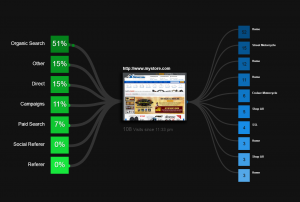
This images shows traffic flow reporting from WebTrends Streams, a analytics product that further centralizes camapign-related data in the user interface.

This snippet of code is making big waves, as Google introduces Universal Analytics as a means to better connect with customers across multiple devices.
Imagine a Christmas wish list for marketers. You can probably imagine improved digital campaign measurement at the top of that list. Thus this year’s changes to analytic solutions can seem like an early Christmas gift. The new features will help marketers make better decisions on customer and sales activity.
For a while marketers have faced an increasing array of marketing media choices. Online marketing strategy was once limited to search and paid search. But QR codes, digital coupons, social media, and video have increased the selection, compounded further by smartphones, tablets, and newly discovered functionality of website design code.
The end result is an environment in which marketers struggle to monitor and to compare various referral traffic sources. eMarketer noted last August that marketers found only half of the current analytics tools “useful”. However, marketers are not deterred. The marketing research firm referenced an Adlogy survey, in which businesses, particularly small businesses, are increasing their budgets for websites and social media. 25% of respondents plan to increase their website development, while another 20% planned for more resources on SEO.
These investment decisions have enticed analytic solution providers to step up their game. Google and WebTrends are among the first providers to incorporated new features meant to address real time reporting from digital campaigns.
WebTrends introduced Streams, an application that integrates data into visual graphic dashboards. These reports can monitor real time influence of customer digital activity across devices and correlate the dataflow against other data, such as KPIs.
There is also more reporting flexibility. For example, Stream users can create filters through writing a SQL-type syntax. This feature adds flexible, tailored to an analyst’s demands instead of that from default settings provided by the solution.
Where as WebTrends created a new application, Google revised its venerable application Google Analytics. Over the past several months Google has released a beta version of its Universal Analytics package (yesterday Google announced that UA is out of the beta phase). This revised tag incorporate capabilities to reflect a more realistic view of how traffic contribution to a conversion goal, including features such as additional configuration options in the reports, time zone based reporting (meaning that the data is updated based on the account's timezone of usage rather than Pacific time), a User ID feature to better connect multi-device traffic sources, and an improved demographic reports. The changes also better positions the solution for web development changes. Read more about Google's full release of Universal Analytics.
A marketer’s understanding of data relative to a given objective is always changing, so a solution redesign to support evolving outlook of data is inevitable. By including more real-time reporting, analytic providers have assured marketers that the gift of more dynamic reporting is not a lump of coal in the stocking.